Hurricane eMatrix
List of Activity Sheets » Community support and public health services
Locating and Establishing Temporary Housing Facilities

Activity Description
- This activity sheet is for response and recovery workers and supervisors siting and establishing temporary housing facilities, regardless of their specific profession or trade.
- For some operations or situations (e.g., using heavy equipment, trenching) other activity sheets also apply; see related activity sheets below.
- As a result of Hurricanes Katrina and Rita (2005), thousands of individuals and families have been displaced. Many of these people were forced to go to temporary shelters during and immediately following the hurricane. As part of the response and recovery effort, the Federal Emergency Management Agency (FEMA) is coordinating establishment of more appropriate temporary family housing facilities, primarily using mobile homes. In addition to housing for displaced persons, FEMA has coordinated establishment of temporary lodging for thousands of response and recovery workers. These lodgings may consist of temporary tent camps, delivered by truck, which worker teams assemble according to need.
- Establishing these temporary housing facilities will involve selecting the site and then using heavy equipment to clear the site, setting the temporary housing units (mobile homes or tents) in place, and building the supporting infrastructure. It also will involve many specially trained technicians to install electrical, water, and sanitation-related services.
- Additionally, once these temporary housing facilities have been established they will need to be maintained to remain operational.
- Response and recovery workers conducting this operation may be employed by Federal, State, local, and private employers. Review How to Use This Matrix in the introduction for a discussion of how this information may apply to different workers.
About the Activity Sheet
This activity sheet does not provide an in-depth analysis of OSHA standards and regulations and cannot address all hazards. It does not increase or diminish any OSHA requirement or employer obligation under those requirements. It is intended as a guide and quick reference for employers and response and recovery workers. The Matrix captures major activities involved in hurricane response and recovery, highlights many of the hazards associated with them, and recommends beneficial work practices, personal protective equipment (PPE), and other exposure control methods. Employers must evaluate the specific hazards associated with the job/operation at the site where the work is being performed.
Employers are responsible for providing a safe and healthful workplace for their workers. OSHA's role is to assure the safety and health of America's workers by setting and enforcing standards; providing training, outreach, and education; establishing partnerships; and encouraging continual improvement in workplace safety and health.
The Hazard Exposure and Risk Assessment Matrix for Hurricane Response and Recovery Work provides a general overview of particular topics related to current OSHA standards. It does not alter or determine compliance responsibilities in OSHA standards or the Occupational Safety and Health Act of 1970, or the equivalent State Plan standards and requirements. Because interpretations and enforcement policy may change over time, you should consult current OSHA/State Plan administrative interpretations and decisions by the Occupational Safety and Health Review Commission and the courts for additional guidance on OSHA compliance requirements. Employers should modify their procedures as appropriate when additional, relevant information becomes available.
Activity-Specific Sampling and Monitoring Information
- Newly manufactured, prefabricated trailers can contain hazardous levels of formaldehyde. Sampling results showed that individuals may be exposed to formaldehyde above allowable levels (i.e., OSHA's PEL) in sealed, unventilated trailers.
- For safety and health monitoring data and sample results, see the Summary of Activity Sampling Data and Safety and Health Monitoring Information.
General Recommendations
Key Engineering Controls and Work Practices. See general recommendations document.
Personal Protective Equipment. The general PPE is recommended for all response/recovery tasks/operations; only the additional PPE that may be needed for a specific hazard is noted below.
General PPE includes:
- Hard hat for overhead impact or electrical hazards
- Eye protection with side shields
- Gloves chosen for job hazards expected (e.g., heavy-duty leather work gloves for handling debris with sharp edges and/or chemical protective gloves appropriate for chemicals potentially contacted)
- ANSI-approved protective footwear
- Respiratory protection as necessary-N, R, or P95, filtering facepieces may be used for nuisance dusts (e.g., dried mud, dirt and silt) and mold (except mold remediation). Filters with a charcoal layer may be used for odors
Recommendations Specific to Hazards Associated with Locating and Establishing Temporary Housing Facilities
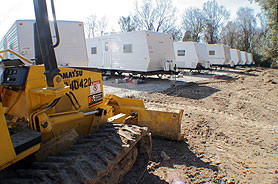
Key Engineering Controls and Work Practices
- See Heavy Equipment and Powered Industrial Truck Use activity sheet
- See Crane Use activity sheet
- See Use of Aerial Lifts activity sheet
Additional Personal Protective Equipment
- Hearing protection-see Noise hazard
- When working from an aerial lift, use a body harness that is properly attached (or body belt for tethering or restraint use only) for fall protection
Key Engineering Controls and Work Practices
- See Work Zone Safety and Traffic Control within a Work Area activity sheet
Additional Personal Protective Equipment
- ANSI/ISEA 107-2004 compliant high visibility safety apparel and headwear
Key Engineering Controls and Work Practices
- Assume that electrical lines are energized until proven otherwise. Lines and other conductors may become reenergized without warning as utilities are evaluated and restored after a disaster
- Inspect the work area for downed conductors and do not go near, drive over, or otherwise come in contact with them
- Downed electrical conductors can energize other objects, including fences, water pipes, bushes, trees, and telephone/CATV/fiber optic cables
- Unless deenergized and visibly grounded, maintain proper distance from overhead electrical power lines (at least 10 feet) and/or provide insulating barriers
- Do not approach any gas leaks; if a gas leak is detected, secure spark-producing devices (e.g., engines, tools, electronic, and communications equipment) and evacuate the area until the leak is secured
- Contact utility company to assist in locating, marking, and shutting off/purging utility lines that may pose a hazard or may be impacted; ensure that lines have been purged as needed before beginning work
Key Engineering Controls and Work Practices
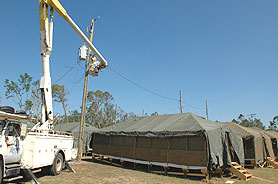
- Assume that electrical lines are energized until proven otherwise; lines may become energized as a result of backfeed from portable generator use, circuit ties/switch point, lightning, or other downstream events
- Ensure that all workers assessing and repairing electrical installations are qualified; a qualified worker is trained in and has demonstrated familiarity with the construction of the equipment to be accessed/repaired and the hazards involved with their work
- Ensure that job briefings address hazards associated with the job, work procedures involved, special precautions, the potential for backfeed from portable generator use, energy source controls, and personal protective equipment (PPE) needs; conduct more detailed briefings for complex or unusual work
- Lines thought to be deenergized may become energized for a number of reasons, including through backfeed from portable generator use; ensure that grounding procedures are accomplished and that all sources of electricity are isolated
- Determine minimum approach distances, energy isolation techniques (e.g., lockout/ tagout, grounding, or equipotential zone needs), and electrical-specific PPE (gloves, face shields) needed based on the type and approximate voltage of service
- Use live-line tools that are rated, pass visual inspection, and are up-to-date in their certification
- Use fall-arrest, work-positioning, or travel-restricting equipment when working more than 4 feet above the ground on poles, towers, or similar structures without fall protection (cages, railings); fall protection equipment is not required to be used by a qualified worker climbing or changing location on poles, towers, or similar structures unless warranted by conditions (weather, design, or presence of hazards)
- See Restoring Electrical Utilities activity sheet
- See Restoring Communications Systems activity sheet
Additional Personal Protective Equipment
- Hard hat with appropriate ANSI rating for exposure to high voltage, as needed
- Appropriately rated and tested electrician's gloves, as needed
- Footwear with dielectric properties for toe cap, insole, and outsole
- Non-conductive clothing, as needed
- Personal fall arrest system including harnesses, lanyards, lifelines, connectors, anchorages, and anchor points (as needed)
Key Engineering Controls and Work Practices
- Limit access/set up controlled access zones
- Use fall protection systems: guardrails, safety nets, or fall arrest systems
- Cover or guard holes and openings as soon as they are created. Covers must support two times the weight (body, equipment, materials) that may be imposed
Additional Personal Protective Equipment
- Personal fall arrest system including harnesses, lanyards, lifelines, connectors, anchorages, and anchor points (as needed)
Key Engineering Controls and Work Practices
- Inspect ladders for cracked, broken, or defective parts before use
- Do not exceed the load rating of ladders or scaffolds-remember that load ratings include people, tools, and equipment
- Set up ladders and scaffolds on stable surfaces
- Set extension or straight ladders at a 75 degree angle from the ground (1/4 foot back for every foot of rise) and provide 3 feet above an upper landing surface to ease climbing onto/descending from height
- Use non-conductive ladders (e.g., fiberglass) and exercise extreme caution when working near power lines
- Secure ladders that can be displaced by work activities; consider barricades at the base to keep traffic away
- Have a competent person inspect scaffolds before use. A competent person is able to recognize existing and predictable hazardous conditions and has the authority to take prompt corrective measures to eliminate the hazardous conditions
- Ensure that the scaffold is plumb, and braced and guyed to prevent tipping, swaying, and displacement
- Ensure that the scaffold is built on base plates and mud sills, or other firm foundations. Footings should be able to support the scaffold without settling or moving. Do not use unstable objects to support scaffolds
- Fully plank each scaffold on all working levels. For wood planking, use wood graded for the intended load
- Provide guardrails or fall protection systems on platforms 10 feet or higher
Additional Personal Protective Equipment
- Fall arrest systems on platforms without guardrails 10 feet or higher
Key Engineering Controls and Work Practices
- For pneumatic nailers, assure that the safety device on the muzzle is operational
- See general recommendations document
Additional Personal Protective Equipment
- Eye protection appropriate to the impact hazard
Key Engineering Controls and Work Practices
- Before starting, check controls, chain tension, bolts, and handles to ensure proper function and adjustment
- Start the saw on the ground or on another firm support with the brake engaged
- Plan the cut; watch for objects under tension; use extreme care to bring objects safely to the ground. Plan where the object will fall; ensure that the fall area is free of hazards; avoid felling an object into other objects; and ensure that a clear retreat path is provided
- Look for nails, spikes, or other metal objects before cutting
- Clear away dirt, debris, small tree limbs, and rocks from the chain saw's path
- Keep hands on handles and maintain secure footing
- To control or prevent chain saw kickback, push-back, and pull-in, use saws that reduce these dangers through chain breaks, low kickback chains, etc.; do not use the saw's tip and keep any tip guards in place
- Do not cut directly overhead
- Shut off/release throttle prior to retreating
- Shut off or engage chain saw brake when carrying a saw more than 50 feet or crossing hazardous terrain
Additional Personal Protective Equipment
- Chaps
- Hearing protection-see Noise hazard
- Eye protection appropriate for additional impact hazard
- Fall protection, as necessary-see Fall hazard
Key Engineering Controls and Work Practices
- See Trenches and Excavations activity sheet
Key Engineering Controls and Work Practices
- Use ground-fault circuit interrupters (GFCIs) or double insulated power tools, or implement an assured equipment grounding program
- Inspect power tool condition (including any cords) and verify operation of safety features before use
- Do not use equipment that is defective, such as equipment with inoperable safety switches, missing guards, frayed/cut cords etc.
- Ground power tools properly
- Avoid standing in wet areas when using portable power tools
Additional Personal Protective Equipment
- Hearing protection-see Noise hazard
- Hand protection for cut- and abrasion-control and vibration dampening
- Eye protection appropriate to the impact hazard
Key Engineering Controls and Work Practices
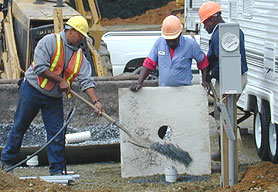
- Stay upwind of or away from dust-generating activities, and in particular those involving crystalline silica-containing materials like concrete, brick, tile, drywall, mortar, sand, or stone. When inhaled, the fine crystalline silica particles contained in the dust can become lodged deep in the lung, which can lead to silicosis and other respiratory illnesses
- Use water spray or mist to suppress dust generation, especially during operations that may create a lot of dust, such as cutting or sawing silica-containing materials, jack hammering, impact drilling, using heavy equipment, and demolishing structures
- Avoid using compressed air for cleaning surfaces
- Sample worker exposures to silica during dust-generating activities
- New trailers and other manufactured housing may continue to off gas chemicals such as formaldehyde; sample worker exposures, as necessary
Additional Personal Protective Equipment
- At a minimum, use respirators with N, R, or P95 filters for work with crystalline silica-containing materials (e.g., concrete, brick, tile, mortar). The use of N, R, or P100 filters may provide additional protection. Higher levels of respiratory protection may be needed for some operations (e.g., cutting concrete, sandblasting, mixing concrete)
- N, R, or P95 respirators may be used for nuisance dusts (e.g., dried mud, dirt, or silt) and mold (except mold remediation). Filters with a charcoal layer may be used for odors
- Based on anticipated level of exposure, a respirator and cartridges for formaldehyde and other chemicals likely to off gas, as necessary
Key Engineering Controls and Work Practices
- Place generators, compressors, and other noisy equipment at a distance or behind a barrier when possible
Additional Personal Protective Equipment
- Hearing protection when working around potential noise sources and when noise levels exceed 90 dBA. A useful "rule of thumb"-if you cannot hold a conversation in a normal speaking voice with a person who is standing at arms length (approximately 3 feet), the noise level may exceed 90 dBA
Key Engineering Controls and Work Practices
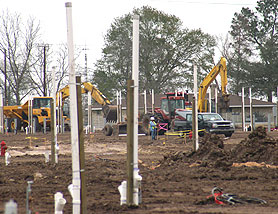
- Never attach a generator directly to the electrical system of a structure unless a qualified electrician has installed a transfer switch for the generator. If the structure's electrical system is not isolated, it may energize the utility's wiring system for great distances and create a risk of electrocution for utility workers and others in the area
- Always plug electrical equipment directly into the generator using the manufacturer's supplied cords or grounded (3-pronged) extension cords that are rated for the total anticipated load
- Do not overload a generator; it can overheat and create a fire hazard
- Ground and bond generators according to the manufacturer's recommendations; ensure that any manufacturer-required connections are secure before using the generator
- Keep the generator dry; protect with a canopy if needed; do not use it in wet or rainy conditions
- Carbon monoxide (CO) is a poisonous, colorless, and odorless gas that is produced by the incomplete burning of the generator's fuel. CO is harmful when breathed because it displaces oxygen in the blood and deprives the heart, brain, and other vital organs of oxygen
- Never use a generator indoors or in enclosed spaces such as garages and basements; opening windows and doors may not prevent CO from building up in those spaces. Do not use a generator outdoors near doors, windows, and vents that could allow CO to enter
- Ensure that a generator has 3 to 4 feet of clear space on all sides and above it to ensure adequate ventilation and cooling
- Before refueling, shut down the generator and allow it to cool
Additional Personal Protective Equipment
- Hearing protection-see Noise hazard
Key Engineering Controls and Work Practices
- Segregate and store incompatible chemicals separately. For example, store solvents and oxidizers (e.g., peroxides) separately, and acids and caustics separately
- Secure compressed gas cylinders and ensure that they are stored properly when not in use (regulators off and valve caps on when not in use; separate oxygen and fuel gas by 20 feet or using a non-combustible barrier (5 ft high, fire-resistant rating of at least ½ hour))
- Store chemicals in containers approved and designed for chemical storage and mark all storage locations
- Store and handle hazardous materials in areas with natural or forced ventilation; do not store or handle in low-lying areas
- Isolate, secure and identify storage areas
- Prohibit smoking near storage areas
- Keep ignition sources at least 25 feet away from storage areas
- Ensure that fire extinguishers and extinguishing agents are available in the immediate area
- Bond and ground containers before dispensing flammable liquids. Reference 29 CFR 1926.152(e)(2)
Additional Personal Protective Equipment
- Gloves made of material that will protect user from chemicals handled
- Face shield or goggles with indirect venting. If a face shield is selected, eye protection must be worn under the face shield
- Coveralls or apron resistant to chemicals being handled
- Disposable boot covers resistant to the chemicals being handled
- A respirator and cartridges specific for chemical, as necessary
Key Engineering Controls and Work Practices
- If hazardous chemical containers are found or leaking materials are detected:
- Do not use spark-producing devices (e.g., engines, tools, electronic, and communications equipment) in the immediate area
- Take self-protective measures (i.e., move to a safe distance upwind) and contact hazardous material response personnel for evaluation/removal before continuing work in the area
Additional Personal Protective Equipment
- Evaluate the need to revise protective clothing, respirator, and glove selection
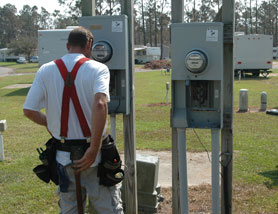
Select any of the following potential hazards that can be associated with this activity in order to access relevant recommendations in the general recommendations document:
Additional Medical Needs
- Follow medical guidance and precautions outlined in the general recommendations document
Additional Training Needs
- Follow general site- and task-specific training guidelines as outlined in the general recommendations document
Related Activity Sheets
- Tree Trimming
- Restoring Electrical Utilities
- Restoring Communications Systems
- Trenches and Excavations
- Heavy Equipment and Powered Industrial Truck Use
- Work Zone Safety and Traffic Control within a Work Area
- Crane Use
- Restoring Water and Sewer Services
- Use of Aerial Lifts
Other Resources and References
- 29 CFR 1926 Subpart P, Excavations. OSHA.
- 29 CFR 1926 Subpart X, Ladders. OSHA.
- 29 CFR 1926 Subpart L, Scaffolds. OSHA.
- 29 CFR 1910.134, Respiratory Protection. OSHA Standard.
- Respiratory Protection. OSHA Safety and Health Topics Page.
- NIOSH Respirator Selection Logic 2004. Centers for Disease Control and Prevention (CDC).
- Working Safely Around Downed Electrical Wires. OSHA Fact Sheet (Publication 3941), (2018).
- Scaffolding. OSHA eTool.
- Using Aerial Lifts. OSHA Fact Sheet, (2005).
- Using Portable Generators Safely. OSHA Fact Sheet, (2005).
- Falls. OSHA Fact Sheet, (2016).
- Working Safely with Electricity. OSHA Fact Sheet (Publication 3942), (2018).
- Working Safely with Chain Saws. OSHA Fact Sheet, (2005).
- Manual on Uniform Traffic Control Devices (MUTCD). US Department of Transportation, Federal Highway Administration.

